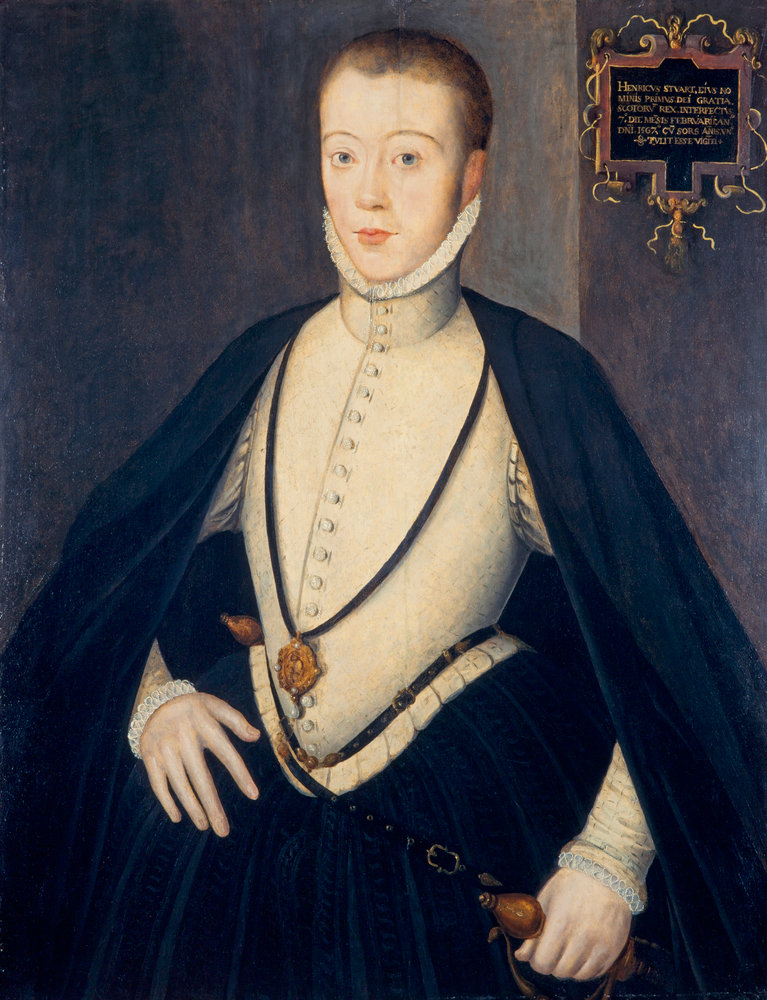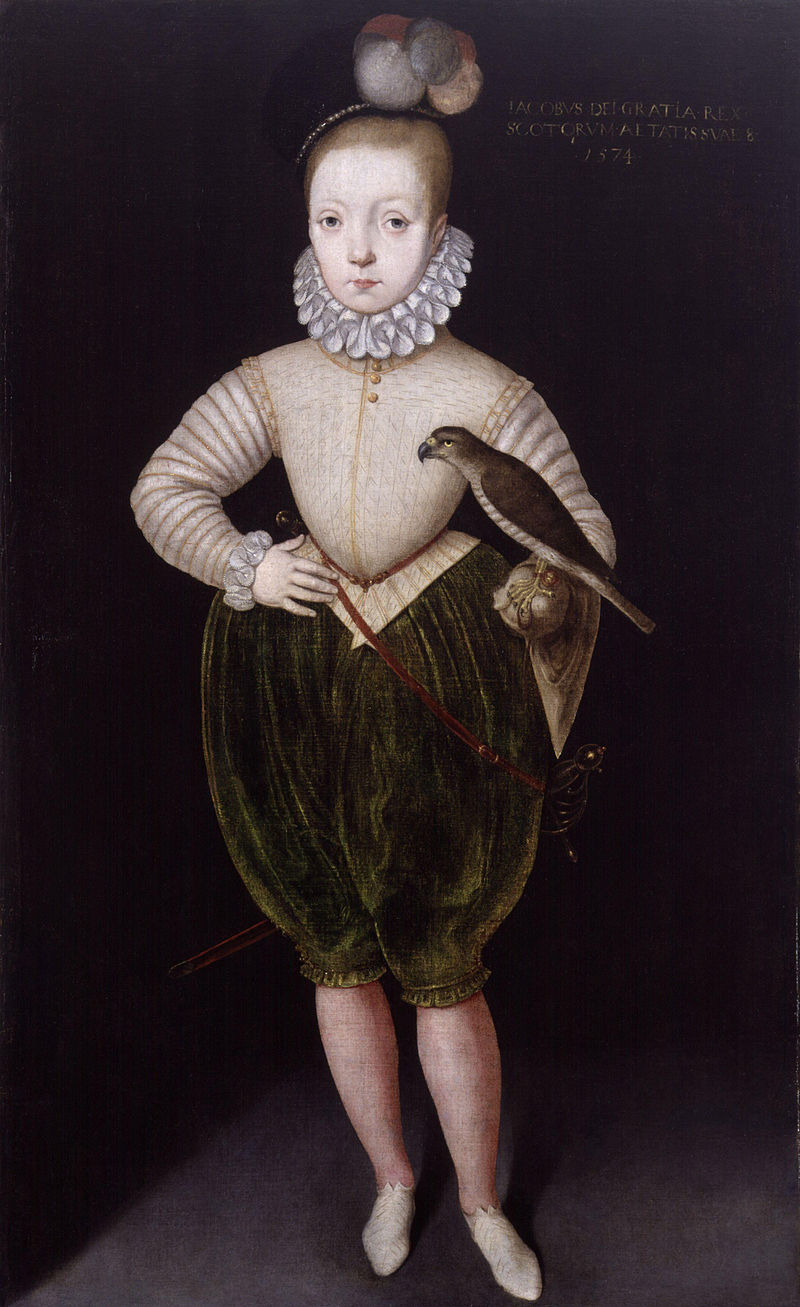by Susan Flantzer
© Unofficial Royalty 2025

Henry Stuart, Lord Darnley and Mary, Queen of Scots; Credit – Wikipedia
On July 29, 1565, in the Chapel Royal at Holyrood Palace in Edinburgh, Scotland, Mary, Queen of Scots, married her first cousin, Henry Stuart, Lord Darnley. Mary and Darnley were both grandchildren of Margaret Tudor, the daughter of King Henry VII of England, and the older sister of King Henry VIII of England. Margaret Tudor was first married to James IV, King of Scots, and they were the parents of James V, King of Scots, Mary’s father. Darnley’s mother, Lady Margaret Douglas, was the only child of Margaret Tudor and her second husband, Archibald Douglas, 6th Earl of Angus.
This was the second of three marriages for Mary, and Darnley’s only marriage. Mary’s first marriage was in 1558 to François II, King of France, then the Dauphin of France. François died in 1560. After Darnley was killed when the house he was staying at was blown up in 1567, Mary married James Hepburn, 4th Earl of Bothwell, in the same year.
Early Life of Mary, Queen of Scots

Mary, Queen of Scots; Credit – Wikipedia
Mary, Queen of Scots was born on December 8, 1542, at Linlithgow Palace in Scotland. She was the third and the only surviving child of James V, King of Scots, and his second wife, Marie of Guise, a French princess. Mary’s paternal grandparents were James IV, King of Scots and Margaret Tudor, the daughter of King Henry VII of England and the sister of King Henry VIII of England, making Mary a potential claimant to the English throne. Mary had two brothers who died in infancy. James V, King of Scots died on December 14, 1542, at the age of 30, and was succeeded by his only surviving, legitimate child, six-day-old Mary.
In July 1548, the Scottish Parliament approved Mary’s marriage to François, Dauphin of France. On August 7, 1548, five-year-old Mary, Queen of Scots, set sail for France, where she would be raised with her future husband. She would not return to Scotland for thirteen years. Ten years later, on April 24, 1558, Mary married François, Dauphin of France, at Notre-Dame Cathedral in Paris. In November 1558, Catholic Queen Mary I of England died and was succeeded by her Protestant half-sister Queen Elizabeth I. Mary and Elizabeth, daughters of King Henry VIII by different mothers, were first cousins once removed of Mary, Queen of Scots. King Henry VIII’s will excluded from the English succession the descendants of his sister Margaret Tudor, Queen of Scots, the paternal grandmother of Mary, Queen of Scots. However, many Catholics considered Mary to be the rightful heir to the English throne.
Seventeen months after becoming King of France, Mary’s first husband, François II, aged 16, died in great pain on December 5, 1560, possibly from mastoiditis, meningitis, or otitis, which turned into an abscess. Left a childless widow, Mary decided to return to Scotland. Catholic Mary returned to a Scotland very different from the one she had left as a child. During Mary’s thirteen-year absence, the Protestant Reformation had swept through Scotland, led by John Knox, considered the founder of the Presbyterian Church of Scotland.
Early Life of Henry Stuart, Lord Darnley

Henry Stuart, Lord Darnley, King Consort of Scots; Credit – Wikipedia
The eldest surviving child of Matthew Stewart, 4th Earl of Lennox and Lady Margaret Douglas, Henry Stuart, Lord Darnley, the second husband of Mary, Queen of Scots, was born on December 7, 1545, at Temple Newsam in Leeds, West Yorkshire, England. Darnley was well-educated and was very conscious of his status and heritage. He had claims to both the Scottish and English thrones as he was descended from both James II, King of Scots and Henry VII, King of England, who was his great-grandfather. Darnley’s family was Catholic and represented an alternative succession to the English throne.
14-year-old Darnley was sent to the French court to complete his education. This coincided with the short reign of François II, King of France, the first husband of Mary, Queen of Scots. Upon the death of François II in 1560, Darnley was at once proposed as a suitable husband for the 18-year-old widowed Queen of Scots. Mary, Queen of Scots.
Reasons for the Marriage
Mary, Queen of Scots needed an heir, so a second marriage became necessary. After considering Carlos, Prince of Asturias, known as Don Carlos, the eldest son and heir of Felipe II, King of Spain, and Queen Elizabeth I’s candidate, Robert Dudley, 1st Earl of Leicester, Mary became infatuated with her first cousin, Henry Stuart, Lord Darnley. Mary, as Queen of Scots, needed to secure an heir and also desired to strengthen her claim to the English throne, currently held by her first cousin once removed, Elizabeth I, Queen of England.
Mary married Darnley mostly for political reasons. He checked off all of Mary’s boxes. Darnley was the grandson of Henry VII, King of England, making him a potential claimant to the English throne and a valuable ally for Mary. She was Catholic, and restoring Catholicism to Scotland was another potential benefit of the marriage, as Darnley was a Catholic. Mary was also drawn to Darnley’s appearance and personality. She found him handsome and charming, and the initial attraction was strong. A week before the wedding, Darnley was created Duke of Albany. The day before the wedding, a proclamation was made in Mary’s name that Darnley would “be named and styled King of this our Kingdom”.
The Wedding
On Sunday, July 29, 1565, between 5:00 AM and 6:00 AM, Mary, Queen of Scots was escorted by John Stewart, 4th Earl of Atholl and Matthew Stewart, 4th Earl of Lennox, the groom’s father, to the Chapel Royal in Holyrood Palace in Edinburgh, Scotland. Mary wore black to her wedding as a symbol of her widowhood and her second marriage. Wearing black was a way to signify her mourning for her first husband. It also indicated that this was not her first marriage, which was not a common practice at the time. Atholl and Lennox then brought Darnley to the chapel. He was wearing a magnificent outfit studded with gems.
John Sinclair, Bishop of Brechin, conducted the Roman Catholic wedding ceremony. Vows were spoken, and three rings, representing the Trinity, were placed on Mary’s finger. Mary and Darnley knelt together, and many prayers were said over them. Darnley left the chapel before the Mass because he wanted to be careful not to offend Protestants. At this point in time, Darnley’s religious beliefs were unfixed. He was raised as a Catholic, but was later influenced by Protestantism.
Afterword
The marriage angered Queen Elizabeth I, who felt that Darnley, as her cousin and an English subject, needed her permission to marry. James Stewart, 1st Earl of Moray, was also angered by his half-sister’s marriage to a prominent Catholic and joined other Protestant lords in a rebellion. Mary soon became disillusioned by Darnley’s uncouth behavior and insistence upon receiving the Crown Matrimonial, which would have made him co-sovereign of Scotland. Mary refused, and their relationship became strained.

Mary and Darnley’s son (circa 1574), James VI, King of Scots after Mary’s abdication, and additionally James I, King of England after the death of Queen Elizabeth I of England; Credit – Wikipedia
On June 19, 1566, at Edinburgh Castle, Mary gave birth to a son, later King James VI of Scotland and King James I of England. He was christened Charles James after his godfather, King Charles IX of France. Mary and Darnley’s son not only succeeded his mother as King of Scots, but he also had another crown. In 1603, as Queen Elizabeth I, the last of the Tudors, lay dying, she gave her assent that Mary, Queen of Scots’ son James VI, King of Scots, should succeed her. By primogeniture, James was the next in line to the English throne. Mary, Queen of Scots is the ancestor of the current British royal family and many other European royal families.
Mary’s marriage to Darnley was all but over, and she began to be drawn to James Hepburn, 4th Earl of Bothwell. Bothwell conspired with Archibald Campbell, 5th Earl of Argyll and George Gordon, 5th Earl of Huntly, to rid Mary of her husband. On February 10, 1567, Darnley was killed when the house he was staying at was blown up.
In April 1567, Mary visited her son at Stirling Castle in Scotland. It was to be the last time Mary would ever see her son. On her way back to Edinburgh, Mary was abducted by Bothwell and taken to Dunbar Castle. Bothwell, who was married, divorced his wife on May 3, 1567, and Mary and Bothwell were married on May 15, 1567. The marriage angered many Scottish nobles, who raised an army against Mary and Bothwell. On July 24, 1567, Mary, Queen of Scots was forced to abdicate in favor of her one-year-old son James, and Bothwell was driven into exile. He was imprisoned in Denmark, became insane, and died in 1578.
In 1568, Mary escaped from her imprisonment at Loch Leven Castle. Forced to flee to England, Mary was soon imprisoned by Queen Elizabeth I of England, her first cousin once removed. Mary was moved from castle to castle, all of which were in the interior of England and away from the sea for security reasons.
In August 1586, Mary was implicated in the Babington Plot, a plot to assassinate Queen Elizabeth I. Shortly afterward, Mary was moved to her final place of imprisonment, Fotheringhay Castle in Northamptonshire, England. Elizabeth I was reluctant to sign the death warrant of an anointed queen. However, on February 1, 1587, Elizabeth signed the death warrant. Having found out she was to be executed the next day, Mary spent her final night praying in Fotheringhay Castle’s small chapel. She was beheaded on a scaffold in the Great Hall of Fotheringhay Castle on February 8, 1587.

Tomb of Mary, Queen of Scots in Westminster Abbey; Credit – Wikipedia
Mary was 44 years old and had spent the last nineteen years of her life imprisoned in English castles. She had requested to be buried in France, but Elizabeth I denied the request. Her remains were embalmed, placed in a lead coffin, and stored in Fotheringhay Castle until August 1, 1587, when they were interred at Peterborough Cathedral. In 1612, Mary’s remains were exhumed upon the orders of her son, King James I of England, and were reburied in a marble tomb with a beautiful effigy in Westminster Abbey in a chapel directly across the aisle from the chapel containing the tomb of Queen Elizabeth I.
This article is the intellectual property of Unofficial Royalty and is NOT TO BE COPIED, EDITED, OR POSTED IN ANY FORM ON ANOTHER WEBSITE under any circumstances. It is permissible to use a link that directs to Unofficial Royalty.
Works Cited
- Flanters, Susan. (2017). Henry Stuart, Lord Darnley, King Consort of Scots | Unofficial Royalty. Unofficialroyalty.com. https://www.unofficialroyalty.com/henry-stuart-lord-darnley/
- Flantzer, Susan. (2016). Mary, Queen of Scots. Unofficial Royalty. https://www.unofficialroyalty.com/mary-queen-of-scots/
- Henry Stuart. (2015). Wikipedia. https://en.wikipedia.org/wiki/Henry_Stuart
- Wedding of Mary, Queen of Scots, and Henry Stuart, Lord Darnley. (2025). Wikipedia. https://en.wikipedia.org/wiki/Wedding_of_Mary,_Queen_of_Scots,_and_Henry,_Lord_Darnley
- Weir, Alison. (2007). Mary, Queen of Scots, and the Murder of Lord Darnley. Random House.
- Wikipedia Contributors. (2019). Mary, Queen of Scots. Wikipedia; Wikimedia Foundation. https://en.wikipedia.org/wiki/Mary.


